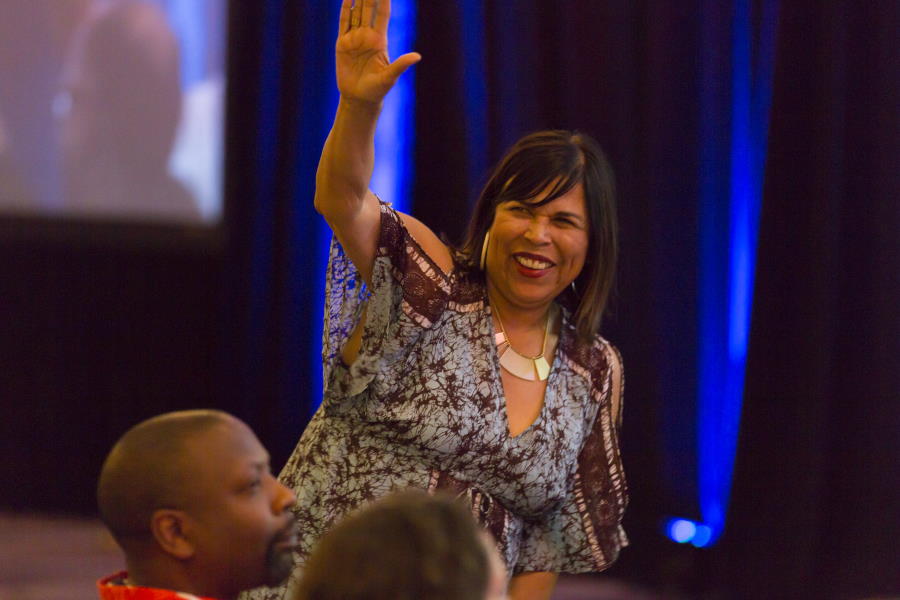I first met the incomparable Diane Rodriguez on a MAP Fund peer review panel convened by the Rockefeller Foundation in the early 1990s. The two Latinas on the panel—she, the intrepid Chicana theatremaker, and me, the Cubanita presenter from Miami—quickly joined forces. It was an instant alliance!
It was a challenging time for the arts, with the country still reeling from the culture wars of the 1980s and early ’90s, and the peer review panel was floundering as to which projects to support. David Mendoza, founding executive director of the National Campaign for Freedom of Expression, said that before there was public funding through the NEA, there was no El Teatro Campesino (where our dear Diane performed for 11 years and met the man who would be her husband, José Delgado, better known as JD), no Northwest Asian American Theater (Seattle), no Guadalupe Cultural Arts Center (San Antonio), no Dance Theater of Harlem, or Ballet Hispanico (New York), and no Newsweek cover for Bill T. Jones, the openly gay, HIV-positive dancer/choreographer. Diane took the lead in the discussion around cultural equity and inclusion before those terms became commonplace in our sector. To the end, these issues were deeply important to Diane. Her concern about the lack of racial, ethnic, and gender diversity in our field was heartfelt, and it was evident in her work as an artist, producer, administrator, and field leader.
She and I lived on opposite coasts, before the age of Zoom and social media, so we saw each other only occasionally. This changed in 1997, when I moved to New York to be the founding program director of the arts for the Doris Duke Charitable Foundation. Diane, a frequent visitor to New York, would stay at my apartment when she visited. I remember seeing her in Heather Woodbury’s Tale of 2Cities at PS 122. The cast was named Best Ensemble at the 2007 Obies, and Diane stayed with me when she was in town to receive the award. And boy, did she go to the ceremony dressed to the hilt! Real old Hollywood glamor, with a dress of champagne gold silk and a matching feather boa—and she knew how to wear it.
Since the early aughts we were in near-constant and ever deeper contact. In 2004 I invited Diane to join the Women’s Working Group, an assemblage of about 15 women in the performing arts, which meets once a year to discuss both professional and personal challenges and joys—something rare in our hyper-professional environment. Ever full of confidence and purpose, Diane traveled to our gathering in Oaxaca, Mexico, and was instantly embraced by the WWG. She would later invite Theatre Communications Group executive director Teresa Eyring to join the WWG. Notably, it was during our last WWG meeting together at the Robert Rauschenberg Foundation in Captiva, Fla., that the tests Diane had for for what was later diagnosed as cancer were coming to light.

Many tributes to Diane have been written by her friends and colleagues in Southern California, where I live now, focusing on the tremendous impact she’s had here. But her contributions to the field went much further, nationally and internationally. Whether chairing the TCG board of directors, serving on the NEA National Council, or seeing work in the Netherlands or Chile, Diane’s keen intellect, natural leadership, compassion, and kindness were a hallmark. She is the reason I am in L.A. (she talked me into going for the L.A. Dept. of Cultural Affairs executive director position, then put together a small group of Latinx artists and arts administrators to lobby Mayor Villaraigosa on my behalf). Had she not done so, I would not have met my husband, Kerry English. She was the matron of honor at our wedding at the Music Center, where Center Theater Group, one of the country’s leading LORT theatres, is housed, and where she worked for 24 years. As usual, she was beaming and dancing her heart out to a Cuban charanga band at the reception.
Diane, with significant funding support from the L.A. Cultural Affairs, also launched the RADAR LA Festival with the Marks (Murphy and Russell, of REDCAT and Under the Radar, respectively). Based on the awareness that L.A.’s ensemble theatres, to whom Diane was especially dedicated, were often overshadowed by the region’s film industry in the view of the world, we wanted to showcase the area’s premier companies alongside the best from the country and the world, with a special focus on Latin American and Asian artists to highlight the connectivity of Los Angeles to those world regions. Ultimately, that was what is so special about Diane: championing local artists while recognizing and celebrating artists from other worlds and other cultures.
As Diane’s health became more and more precarious, her besties surrounded her and JD to help make her passage more loving and comfortable. The outpouring of grief has been incredible. But so has the outpouring of joyful memories of how Diane matters, and how she impacted so many people’s lives. She is unforgettable, and I am truly privileged to have called her hermana.
Olga Garay-English, an independent arts consultant since 2014, served as director of the L.A. Department of Cultural Affairs from 2007 to 2014.





